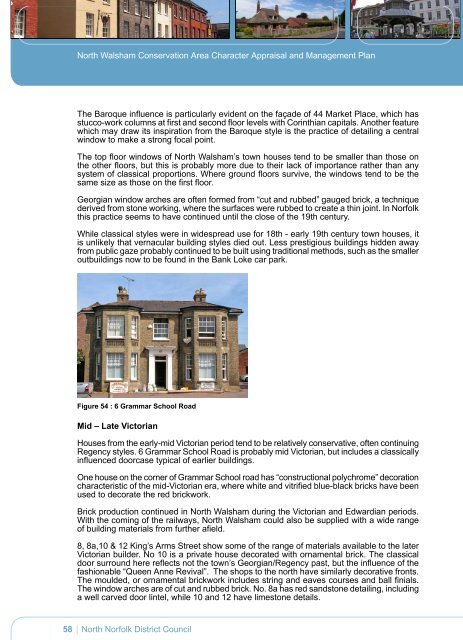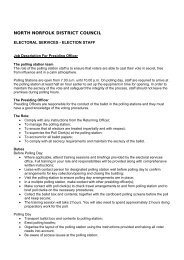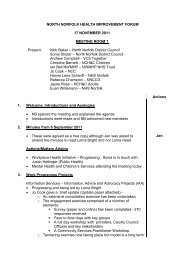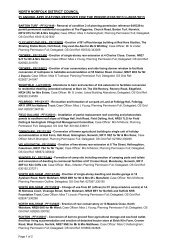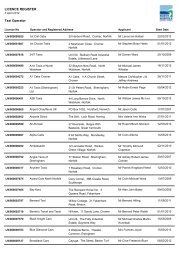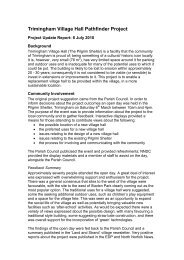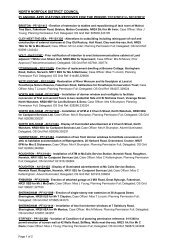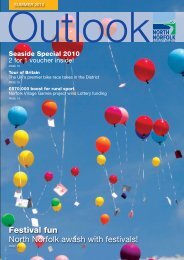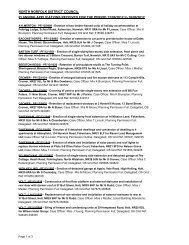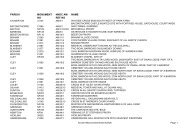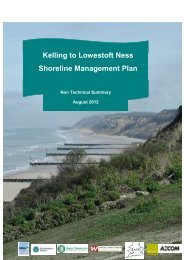NW CA cover:Layout 1 - North Norfolk District Council
NW CA cover:Layout 1 - North Norfolk District Council
NW CA cover:Layout 1 - North Norfolk District Council
- No tags were found...
Create successful ePaper yourself
Turn your PDF publications into a flip-book with our unique Google optimized e-Paper software.
<strong>North</strong> Walsham Conservation Area Character Appraisal and Management PlanThe Baroque influence is particularly evident on the façade of 44 Market Place, which hasstucco-work columns at first and second floor levels with Corinthian capitals. Another featurewhich may draw its inspiration from the Baroque style is the practice of detailing a centralwindow to make a strong focal point.The top floor windows of <strong>North</strong> Walsham’s town houses tend to be smaller than those onthe other floors, but this is probably more due to their lack of importance rather than anysystem of classical proportions. Where ground floors survive, the windows tend to be thesame size as those on the first floor.Georgian window arches are often formed from “cut and rubbed” gauged brick, a techniquederived from stone working, where the surfaces were rubbed to create a thin joint. In <strong>Norfolk</strong>this practice seems to have continued until the close of the 19th century.While classical styles were in widespread use for 18th - early 19th century town houses, itis unlikely that vernacular building styles died out. Less prestigious buildings hidden awayfrom public gaze probably continued to be built using traditional methods, such as the smalleroutbuildings now to be found in the Bank Loke car park.Figure 54 : 6 Grammar School RoadMid – Late VictorianHouses from the early-mid Victorian period tend to be relatively conservative, often continuingRegency styles. 6 Grammar School Road is probably mid Victorian, but includes a classicallyinfluenced doorcase typical of earlier buildings.One house on the corner of Grammar School road has “constructional polychrome” decorationcharacteristic of the mid-Victorian era, where white and vitrified blue-black bricks have beenused to decorate the red brickwork.Brick production continued in <strong>North</strong> Walsham during the Victorian and Edwardian periods.With the coming of the railways, <strong>North</strong> Walsham could also be supplied with a wide rangeof building materials from further afield.8, 8a,10 & 12 King’s Arms Street show some of the range of materials available to the laterVictorian builder. No 10 is a private house decorated with ornamental brick. The classicaldoor surround here reflects not the town’s Georgian/Regency past, but the influence of thefashionable “Queen Anne Revival”. The shops to the north have similarly decorative fronts.The moulded, or ornamental brickwork includes string and eaves courses and ball finials.The window arches are of cut and rubbed brick. No. 8a has red sandstone detailing, includinga well carved door lintel, while 10 and 12 have limestone details.58<strong>North</strong> <strong>Norfolk</strong> <strong>District</strong> <strong>Council</strong>


